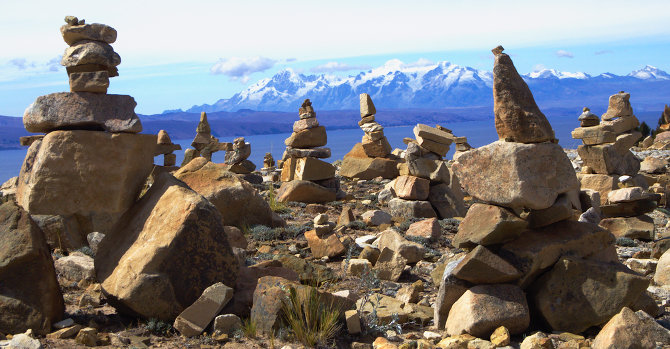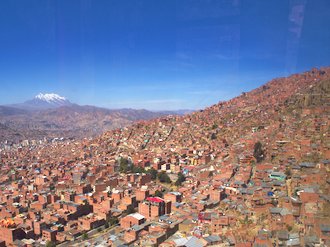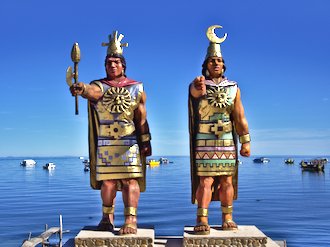Jun 12, 2016 1
Backpacking South America (Part 4)
In the last weeks we have been to La Paz for some time, among other cities. I was surprised by the city, as I had anticipated a different vibe. In fact we found a modern city with a wide variety of alternative offers. Stumbling into an alternative market at night or eating at a vegan community kitchen, for example. The city has a very unique architecture, it really looks like it was build in a huge dent in the ground (photo at the bottom of this post). This means the houses are all on a steep slope. Our hostel was deep down in the dent and especially at night this was a unique scenery, since the slope was illuminated by countless houses and street lights.
It is very notable how many people we see with the South America Lonely Planet openly running around the city. I have been critical to the series in the past, but during the last weeks I have become even more critical. Since we have one of their guidebooks with us as well I see firsthand what this kind of mainstream backpacking inflicts. Travelers who would normally never have visited certain places do now, blindly following the “travelling bible”. This leads to the effect that once nice and secluded villages get overthrown by tourism within a few years and there is only little left of the original charm. I really hope that some of the really nice and secluded villages in Mexico never make it into one of the editions. I am sure this would otherwise spoil their magic.
In the last week I got more and more bothered by cities which are very touristy. We are currently in Copacabana and this is a sad example therefore. So many boring tourists. They all seem to have the same uniform, the obligatory Lonely Planet with them, visiting the same places, doing the same things. I feel that India and Mexico are countries where tourists like that just don’t emerge. Maybe this is due to the reputation of these countries. It makes me miss the vibe of those countries.
In the meantime I have finished three further books. The first was “How to write a Short Story” by Christopher Fielden. Whilst travelling I went through some creative writing material of mine that dates back some years. I was surprised by the quality of it and decided to hand it in to some competitions. Whilst researching, I stumbled upon the aforementioned book and read it. It contains a number of writing tips and insights into the short story/flash fiction scene. This has encouraged me to actually submit two stories to competitions. Besides that there were still things which I couldn’t identify with in the book. My most critical point is that the author suggests to do market research when writing stories and adapt the story material based on that. This is a different approach than I have to writing stories. For me, the trigger to write something is never a competition, it is always a personal experience or an idea that I aim to put into the best story I can write. Doing market research and adapting a story for a certain audiences contradicts my attitude. Nevertheless, the book was a worthwile read. It was quite entertaining and funny, especially since the author includes own short stories and details the work he put into them and how he adapted them based on the feedback of competition judges.
The second book which I finished is “Marching Powder” by Rusty Young. I got to know about the book after skipping through an old “Rough Guide to Peru” which lay around at a place where we stayed. The book mentioned the infamous San Pedro prison tours and after some research online I found this blog post. This was more than enough to get me interested in reading the book. The book tells the autobiographical story of Thomas McFadden who got imprisoned in La Paz (in the San Pedro prison) for international drug trafficking. Read the above mentioned blog post if you are interested in more details about this very unusual and infamous prison. The book is for sure my most favorite book since quite a while. It grabbed my full attention after I had started reading the first page and I am still flashed after having read it. Very thrilling. Reading the book was an experience as I imagine reading “The Beach” whilst staying in Thailand on Koh Phangan must be. I knew all of the cities, had been to most of them by now. Though, opposed to The Beach this book is a biography and not a work of fiction. I could relate to culture specific things he wrote and was totally stunned that all of this had happened here where I was, just a brief time ago.
The third book which I finished was Eric Clapton’s autobiography. I think the book could have been a lot better, since he plays his achievements a bit down and often not even mentions them (similar to Stephen King in his autobiography). Nevertheless it is a very honest autobiography and he mentions a lot of incidents which take a lot of courage to admit. After having read the book I started listening back to some of his songs. He describes how they came to be and I could relate to a lot of his creative process and motivations. In my opinion, Wonderful Tonight, My Fathers Eyes, Layla, and Tears in Heaven are songs in a totally different league than an average hit song. This is timeless music which is going to stay. The book also made it clear to me, once more, that at some point in the future I need to look more deeply into The Beatles, Bob Dylan, and The Grateful Dead.
There are a lot of things about the Bolivian culture which I like and we have met countless friendly people. But the macho fuss in this culture really disturbs me. I have already written about the sexism which I observe when we as male/female interact with Bolivians in Part 2 (I mentioned various examples there). But a couple of days ago the most outstanding incident in this direction occurred. We were eating at one of the better restaurant and the waiter handed only me a menu. He then continued to describe the various specialities of the day — again only to me. He didn’t recognize or interact with Val at all. I don’t know what the reasoning behind this is…that I decide what to eat for her as well? Thus, after getting a second menu, we made it deliberate that she ordered our menu and asked for the bill. The waiter, however, was stubborn and handed the bill to me — as experienced in countless other Bolivian restaurants before. I feel it hard to deal with this kind of sexism, since it is so deep in the culture. It saddens me whenever we experience something like this. I have not experienced anything similar in any other country.




